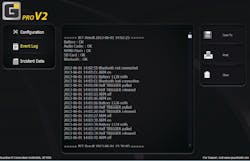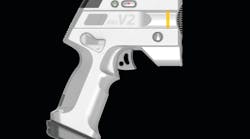New technology fills a gap for security officers
In speaking with security company owners, I regularly hear that their market is under-served in mission-specific equipment. While many note that skills, training, and equipment are key considerations to empower security officers, they often feel that many lack the appropriate duty belt tools to effectively de-escalate situations they face.
Traditional security tools—batons, handcuffs, pepper spray, and flashlights—tend to focus on the officer/subject interaction, but do not provide an all-encompassing solution for communicating with authorities and supervisors while diffusing or responding to an incident. Until now, officers were faced with a choice to either deal with the situation in front of them or communicate with authorities and supervisors for requesting backup, reporting purposes, etc. This doesn’t seem out of the ordinary because incidents have always been dealt with in this manner and the two choices typically couldn’t be done simultaneously. The dynamics of the situation usually dictate in which order the two are chosen; but it will either be one or the other, even though each may be almost equally important when seconds count. In these conditions, officers could face reduced situational confidence and increased injuries and claims.
Whether they are referred to as subjects, suspects or even “uninvited guests," to emboldened subjects, an officer’s unarmed appearance can imply that he is a soft target, resulting in disrespectful behavior and attitude. This will often escalate the situation. During apprehension or crime-related incidents, memory driven reporting that hinges on situational recall sometimes reveals inconsistencies in the narrative and is told from a singular point-of-view by the person reporting the incident. The subject could also refute the officer’s story if there are no other witnesses and that could result in an internal investigation of the incident concerning the officer’s conduct during the apprehension, even if the officer did everything right.
Enhanced Non-lethal Devices
Security professionals need more effective tools that enable them to safely do their jobs. To address the shortage of tools designed for the security professional’s defensive role, a new product category — enhanced non-lethal [ENL] devices — has emerged.
This fully integrated set of tools is designed to improve a security officer’s ability to maintain control and communication in threatening situations. It addresses threat engagement by maximizing the distance between officer and subject. It also promotes accountability by enabling incident reporting supported by images and audio.
With a mission-specific design intended to reduce risk, enhance officer safety and lower operating costs, the layered defense approach enabled by enhanced non-lethal devices can improve safety and job satisfaction. Let’s look at how one company is using this exciting new technology to its competitive advantage by empowering guards and protecting clients.
King Asset Protection Services, LLC: A Case Study
King Asset Protection Services is an executive protection company servicing clients throughout Phoenix and Arizona. With numerous professional athletes making the Phoenix area their year-round home, King’s client base includes current and former professional baseball and basketball players, as well as snowbirds (winter residents) and clients who live in other countries, relying on King services when they’re in Arizona.
President and CEO Roy Norris Jr, a firearms instructor by trade, has a clear perspective on the services he can offer clients and the support his guard staff needs. He is also well aware of the effects of apprehension liability, due to his experience working as a loss prevention executive for Walmart and Target.
In setting up his guard force and establishing protection service agreements, Norris recognized a need to empower his guards by giving them the best situational and tactical perspectives and training for risk mitigation. “As a company owner, I want our guards to put their best foot forward and I can’t ask them to do that without the proper tools,” says Norris. He knows that a well-equipped and well-trained staff will make better decisions on the job.
Offering protection to residential clients, Norris was sensitive about issuing firearms to guards in family homes but he needed a solution to mitigate risk during home response, so he began to search for risk appropriate alternatives to empower his staff.
Initially, he armed his staff with batons, but was uncomfortable with the potential liability his company could face following the use of an impact weapon. Norris also considered using a popular model of contact stun devices, but the $1,500 price tag on a camera-equipped conducted electrical weapon (CEW) was not cost-effective and was considered too aggressive for the risk mitigation process.
Enhanced Technology
At a meeting of the Arizona Private Security Professionals Association, Norris saw a demo of a locally produced Enhanced Non-Lethal (ENL) device. The ENL- in this case a G8 Pro V2 manufactured by Guardian 8 - was a lightweight, duty-belt device designed to give guards a single tool that provides multiple layers of defense, a command center communication link and automatic incident recording capability.
After the meeting, Norris could not tell if his colleagues at the meeting understood the impact of the technology they had witnessed, but he saw an immediate fit for ENLs in his organization. “To combine all those features into one unit; I was happy to see someone was thinking on the level that I was,” he says. The sub-$300 price tag also fit the economic needs of his growing company.
Tailored to the private security market, ENLs enable users to interact and communicate with potential threats while also alerting and communicating with authorities and their own central command center. As a situational awareness and response technology solution, guards can access push-to-talk connectivity with support personnel, capturing audio and still images automatically every time the unit is armed.
With a combination of low-impact tools, ENLs provide a layered defense (as an alternative to force) from up to 50 feet away, establishing overlapping protection zones with increasing levels of non-lethal response. These layered defense levels include:
- Level 1 – Laser spotter, camera and auto-record functionality can be used to try to modify a subject’s behavior.
- Level 2 – The ENL can send a pre-recorded message via the user’s mobile phone and enable push-to-talk capabilities. An alerting siren and strobe light can also be used to call attention to the incident and disorient the subject.
- Level 3 – Users can activate OC pepper spray to affect aggressive subjects from up to 10 feet away.
Breaking from Tradition - ENL in Action
Initially, Norris purchased five G8 Pro V2 units for his staff, implementing them with guards immediately. He knew he was adopting a pioneering technology, but felt confident with his decision. “Other companies look at technology purchases as an expense, but I see the ENL device as an insurance policy on my guys’ health and well-being, ensuring they have the ability to address issues as they see fit,” says Norris.
He found the adoption of ENLs was different from traditional tools in the security realm. Norris adds, “To get used to it, we had to break away from tradition. The old guard is used to the baton. As we move forward, we’ve got to look at risk mitigation.”
The device raises the confidence level of guards at King Asset Protection, and provides an advantage for evidentiary retention. “A lot of the time, what prevents guards from stepping up and doing the right thing is that it could be their word against someone else’s. Recording and capturing audio and video empowers my guards to make great decisions,” says Norris, who views the ENL as a force multiplier. “As a small company, it allowed me to take 15 guys and make it feel like we had 115 guys. Because of the communication and auto-record functionality, our security was far ahead of everyone else’s.”
The configurable device is flexible in allowing for an appropriate response. “In some cases, we set it up so that the call goes directly to our supervisor so they can address the situation instantly. Not only are you recording the situation, you’re talking directly to a supervisor. So as a force multiplier, the individual we’re pointing the laser at begins to understand that help is on its way.”
With a handle, grip and holster that cater to security pros, the ENL device’s pistol size and shape are visually recognizable and familiar to users, though Norris notes that it’s a little bigger than what he would prefer. He feels the size could be cumbersome for guards who are also armed. “If a guard is not armed, it’s a perfect solution. If he’s armed, he may have to cross draw, which could be a little tricky,” he says.
By ensuring that clients, guards and the company are protected, King’s pioneering use of ENLs has also proven to be successful in attracting new clients, allowing the company to demonstrate a technological advantage over competitors. Norris notes, “When we make proposals to prospective clients, they want to see something different, . . . something ‘next generation.’ Clients are drawn to a technologically superior service, and that’s one way we differentiate ourselves,” he adds.
Simplify Complex Risks
After the initial trial, Norris purchased more ENLs to supply clients and King Asset Protection guards, and anticipates continuing to provide ENLs to new guards as the company grows. King’s pioneering use of ENL devices clearly demonstrates that when choosing tools for your officers’ duty belts, the goal is to:
- Encourage the use of products that provide a layered defense and reduce legal risks arising from interpersonal conflicts;
- Enhance employee retention with bolstered confidence; and
- Lower operating costs by reducing the time and expense that goes into hiring and training a security officer/guard force.
By enabling his guards to meet threats with an appropriate response, using technology to maximize the engagement distance and thorough reporting of incidents, Norris has seen the instant morale transformation that comes with providing the right training and tools for the job.
About the Author: Chandler Garrett is a retired deputy sheriff with extensive tactical training and has been a police trainer for over 15 years. He is a recognized expert on CEWs and use of force. Chandler is president and founder of a personal defense consulting company and also serves as director of the southern U.S. for the industry’s leading manufacturer of tactical equipment, apparel and gear.



